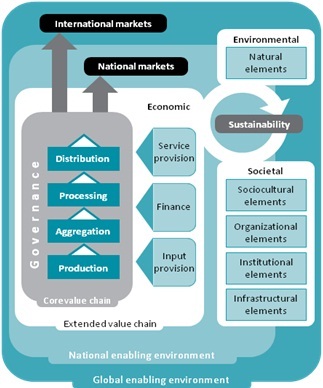Value chain and food loss and waste
A food value chain (FVC) consists of all the stakeholders who participate in the coordinated production and value-adding activities that are needed to make food products.
A sustainable food value chain (SFVC) is a food value chain that:
• is profitable throughout all of its stages (economic sustainability);
• has broad-based benefits for society (social sustainability);
• has a positive or neutral impact on the natural environment (environmental sustainability)
The SFVC concept recognizes that value chains are dynamic, market-driven systems in which vertical coordination (governance) is the central dimension and for which value added and sustainability are explicit, multidimensional performance measures, assessed at the aggregate level. The SFVC development framework considers the FVC as the core of a system of complex economic, social and natural environments that determine the behavior and performance of farms and other agrifood enterprises.
The core FVC comprises the value chain actors who produce or procure products from the upstream level, add value to these products and then sell them on to the next level. These actors carry out four functions: production (farming, fishing, forest harvesting or agroforestry), aggregation, processing, and distribution (wholesale and retail). The aggregation step is especially important to FVCs in developing countries, where efficiently aggregating and storing small volumes of produce collected from widely dispersed smallholder producers is often a major challenge.
FVC actors are linked to each other and to their wider operating environment through a governance structure. There are horizontal linkages among the actors at a particular stage of the chain, for example farmers organizing themselves into cooperatives; and vertical linkages within the overall chain, for example farmers providing their produce to food companies through contracts.
Ultimately, value is determined by consumers’ choice of food items to purchase on national and international markets. The implication is that SFVC development starts from an opportunity in the market place and works backwards through the chain to identify what aspects need to be improved to capture this opportunity.
Figure 1. The Sustainable Food Value Chain Framework

Food loss and waste has indeed become an issue of great public concern. The 2030 Agenda for Sustainable Development reflects the increased global awareness of the problem. Target 12.3 of the Sustainable Development Goals calls for halving per capita global food waste at retail and consumer levels by 2030, as well as reducing food losses along the production and supply chains.
Food loss is the decrease in the quantity or quality of food resulting from decisions and actions by food suppliers in the chain, excluding retailers, food service providers and consumers. Empirically, it refers to any food that is discarded, incinerated or otherwise disposed of along the food supply chain from harvest/slaughter/catch up to, but excluding, the retail level, and does not re-enter in any other productive utilization, such as feed or seed.
Food waste refers to the decrease in the quantity or quality of food resulting from decisions and actions by retailers, food service providers and consumers. Food is wasted in many ways:
- Fresh produce that deviates from what is considered optimal, for example in terms of shape, size and color, is often removed from the supply chain during sorting operations.
- Foods that are close to, at or beyond the “best-before” date are often discarded by retailers and consumers.
- Large quantities of wholesome edible food are often unused or left over and discarded from household kitchens and eating establishments.
Less food loss and waste would lead to more efficient land use and better water resource management with positive impacts on climate change and livelihoods.
Under the WEPS regional project, a regional methodology for assessing the economic water productivity along the value chain is being developed and applied to some of the targeted countries under the project.
